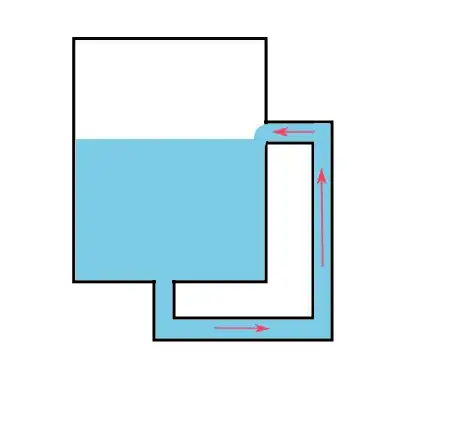The water is supposed to run infinitely in this container, since when water drops the pressure inside the container decreases, which makes the water in the pipe ascend. I know that perpetual motion violates the second law of thermodynamics, I tried to find the flaw in this machine, the only thing I could think about is that when pressure drops in the container that makes water boils which prevents the pressure from decreasing, or that the dropping in pressure prevents the water in the container from dropping in the first place.
4 Answers
The water will just sit at an equilibrium level with the horizontal pipe on top half filled. And even if the water was moving, viscosity will slow it down over time and the system will lose energy to heat.
- 8,778
In the picture in the question the water level in the pipe on the right is higher than in the main container. This makes the pressure at the bottom of that pipe higher than in the main container, so the water flows the other way. When the two levels are equal the pressures are balanced so the water stops flowing (since then even a very small amount of viscosity is sufficient to bring it to rest).
In the case of flow without friction, such as the electron-pairs in a superconducting loop, you can have a flow which does not stop. This is like a body in outer space with no forces acting on it: it can move at constant velocity. This is a kind of perpetual motion but in practice it won't last for ever because the superconducting material will itself break up eventually. (And if you tried to extract energy then the current will change of course).
In individual atoms there is a kind of motion in the electrons. Some of these atoms have been around for billions of years with the electrons in motion continuously.
- 65,285
...since when water drops the pressure inside the container decreases, which makes the water in the pipe ascend.
The water rises in the pipe only if the total pressure from the left is greater than the total pressure on the right.
If the air pressure in the container decreases, it reduces the total pressure on both sides, so no benefit is gained.
- 42,997
- 3
- 68
- 123
...when water drops...
What would make it drop? Water is, for all practical purposes, incompressible. If water was flowing in the pipe as shown by the red arrows, then the rate at which it flows in to the main chamber at the top of the pipe must always be exactly equal to the rate at which it leaves the chamber to enter the pipe at the bottom. The amount of water flowing in always equals the amount of water flowing out. The amount of water in the main chamber therefore will not change. The level will not go down.
...the pressure inside the container decreases, which makes the water in the pipe ascend.
OK, we already know that the air pressure won't change because the water level won't drop, but suppose you attached a vacuum pump at the top of the chamber and forcibly reduced the air pressure. Would that make the water flow?
Fluids transmit pressure equally in all directions. The chamber is filled with nothing but fluids (air and water.) If you reduce the pressure anywhere in the chamber, you'll be reducing it everywhere by exactly the same amount. Changing the pressure at both ends of the pipe by the same amount will not change the rate of flow.
All that's left is momentum. If the water is moving as shown by the red arrows, then its momentum will cause it to continue to move. But, as other answers have mentioned, friction within the water and, between the water and the walls of the pipe, will soon kill that motion.
- 17,057
